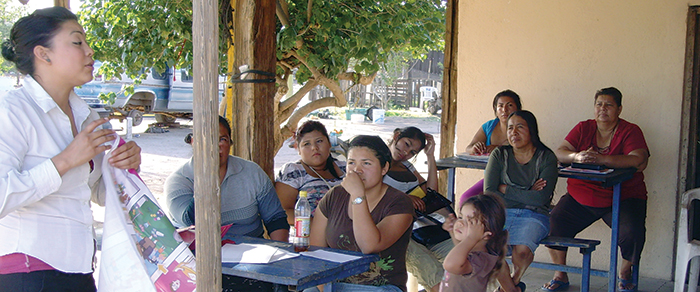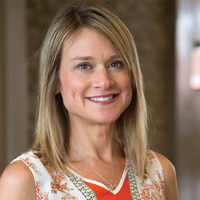
A loan officer in Sonora, Mexico, explains insurance products using a poster created by assistant professor Jonathan Bauchet. His research has examined the demand for life microinsurance in developing countries. (Photo provided)
Some families in the world's poorest countries may spend half of their yearly income on a funeral for a loved one. Those families struggle to develop plans to meet these expenses, particularly since they have limited access to loans and other financial services.

Jonathan Bauchet (Photo by Mark Simons)
But thanks to research by Jonathan Bauchet, assistant professor of consumer science, families in that situation may now be better able to manage their financial needs and make the best of limited resources.
Bauchet is among a growing number of researchers taking a closer look at the financial life of those in impoverished households. Specifically, his recent research has focused on human behavior associated with saving, borrowing and purchasing of insurance in poor households in developing countries.
"We used to think these households were too poor to save and couldn't afford loans or insurance," Bauchet says. "But research in the last decade shows that's not the case at all. These families actually need to have access to a complete set of appropriate financial services because being poor means that their income is not only very low, but also highly irregular."
Bauchet's interest in the area of finance for poor households in developing countries stems from his time as a development worker in Haiti.
"I see my research as an effort to inform policy in order to increase its positive impacts on poor people's lives," he says. "I want to connect with policymakers and practitioners to figure out ways we can offer poor families financial tools to help them create better lives."
In particular, he has examined the demand for life microinsurance among microfinance borrowers in Mexico. Microinsurance is so-named because of its low premiums and payouts, specifically designed for poor households.
In the case of the life insurance product Bauchet studied, premiums are approximately $4.50 for four months of coverage with a $1,300 payout. Microinsurance also has very simple registration and payout options, and fewer conditions and exclusions than typical insurance products.
"Insurance companies want to make microinsurance plans as simple as possible to prevent confusion," Bauchet says. "Lack of understanding is one of the top reasons poor households do not use formal insurance products to protect themselves against the many risks they face. If they cannot understand the benefits of the insurance, they are not going to buy in.
"Poor households face many risks, particularly when it comes to health, yet many do not buy insurance. My research looks at why they don't buy and how providers can improve selling techniques because these insurance plans are designed to help the families survive when they experience major health issues or the death of a loved one."
Bauchet analyzed the promotion techniques a bank in Mexico was using to sell life insurance to its poor clients. He discovered two very distinct selling mechanisms — one that focused on providing financial information and one that focused on emotions as a driver of purchases. The financial data-based technique promoted the monetary benefits of having life insurance versus the consequences of not having the insurance when the family experienced the loss of a loved one. Emotion-based selling used illustrated cartoons to advertise the peace of mind that the life insurance provides.
"We found that the financial information worked better for middle-aged adults, while the emotional message appealed to younger adults," Bauchet says. "This means that one size does not fit all, but the message must be tailored to the targeted population to help them see why microinsurance is a valuable tool."
Bauchet also studies the impact of saving and borrowing on people living in impoverished households. He says that in the 1960s many governments in poorer countries tried to establish banks to issue loans to poor families. But most of them were not successful because repayment rates were very low — in some cases, as low as 50 percent.
"That changed in the 1980s, when Muhammad Yunus established the Grameen Bank in Bangladesh to extend poor people small loans on easy terms," Bauchet says. "Instead of individual loans, he gave loans to entire groups of women from the same village, which meant people felt more compelled to pay back because of the peer pressure aspect."
Yunus and the Grameen Bank received the Nobel Peace Prize in 2006 for their work to create banking programs for the poor. The Grameen Bank served as the inspiration for hundreds of savings and loan companies to start operations in poor countries.
"It kicked off a movement of institutions offering poor families places to save and borrow within the formal financial system," Bauchet says.
In addition to planning another microinsurance experiment with a bank in Colombia, Bauchet is planning to take a closer look at mobile banking options in poor countries, such as the mobile phone-based money transfer and microfinancing service called M-Pesa in Kenya.











